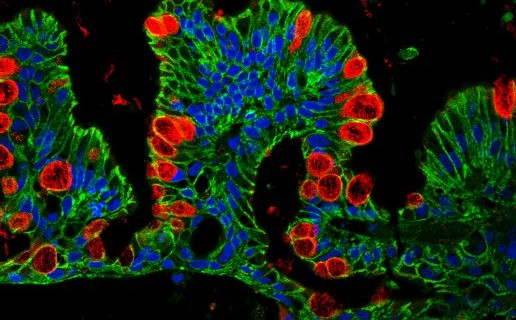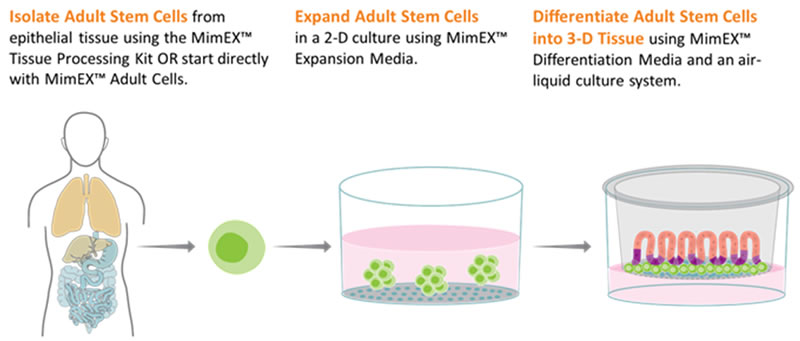
Novel 3D Cell Culture System Simplifies Tissue Culture Model Creation
3D Cell Culture vs. 2D Cell Culture
The development of three-dimensional (3D) cell culture as a system to better model in vivo cytoarchitecture has been evident over the past several decades. Historically, flat, two-dimensional (2D) monolayer cells were the only practical option for cell-based screening and they have proven their utility for drug discovery. However, it is also evident that these 2D culture systems are limited in their ability to recapitulate normal tissue responses because they lack tissue-specific cytoarchitecture, in vivo mechanical and biochemical cues, and cell-to-cell and cell-to-matrix interactions.
Organoids (or “mini-organs”) for various organ systems have gained popularity as a more physiologically relevant model for in vivo cellular responses. These more complex models improve upon cell-line and primary cell-based methods with their ability to mimic native cytoarchitecture and to recapitulate physiological attributes of the native tissue. However, common challenges with these 3-D models such as model variability (size and shape of organoids), maintaining tissue viability, and experimental accessibility (restricted access to apical surfaces) still need to be addressed. Overcoming these obstacles is paramount before 3D tissue systems can be incorporated into high throughput toxicity, biomarker and drug discovery, and disease modeling workflows.
To address these challenges and enhance 3D cell culture performance, R&D Systems, a Bio-Techne brand, recently launched a novel 3D tissue culture model platform. MimEX™ Tissue Model Systems is a next-generation 3-D tissue culturing platform that combines the utility of stem cell-based organoid platforms with the accessibility of primary tissue culture models. MimEX™ GI, the first system released using this technology, utilizes the unique characteristics of adult “ground state” stem cells to generate 3-D gastrointestinal organ tissue on a 2-D surface allowing researchers to more easily incorporate these models into their workflow.
MimEX™ Workflow
Adult ground state stem cells isolated from region-specific organ tissue are expanded in 2-D cell culture using MimEX Expansion Media and MimEX Irradiated Feeders. The expanded stem cells are plated as a high density monolayer in transwell inserts and differentiation is initiated using MimEX Differentiation Media in an air-liquid interface system. The resulting 3-D tissue recapitulates the structure and function of the organ from which the stem cells were derived, and is oriented such that the apical surface of the epithelium is accessible for ease of experimental manipulation.

Advantages of the MimEX™ Tissue Model System
The power of MimEX Platform lies in the region-specific memory of “ground state” adult stem cells. In the MimEX GI system, cells can be clonally isolated from specific regions of the adult gastrointestinal tract and expanded in vitro. Then, using the MimEX GI Differentiation Media, these region-specific stem cells can differentiate back into its respective tissue of origin, ex vivo. This differentiation is uniform and is oriented such that the apical surface of the mucosa is accessible for experimentation. Additionally, the GI tissue generated with this platform shows predictable response to different molecules as evidence for the flexibility of this tissue in high throughput protocols.
Accessible Epithelium
Typically, the epithelial layer in organoid models typically faces the interior of the 3D structure, limiting that surface for experimental access necessitating more complicated procedures like microinjection to reach the cells facing the lumen. Tissues generated with the MimEX System overcome this challenge. As the monolayer of tissue-specific stem cells differentiates in the air-liquid interface of the transwell insert, a polarized epithelium forms with the apical surface fully accessible from the top of the cell culture plate. These “open-faced organoids” allow researchers to add compounds, drugs, or toxins directly to the epithelium surface.
Tissue Consistency
Tissue generated from the MimEX System arise from a monolayer of adult stem cells thereby providing the researcher control over the size and shape of their 3D cell culture model by changing the size of the transwells, which can be variable in traditional organoids formed from tissue explants.
Region-specific Organ Tissue
Generalized 3D tissue models may have less predictive power than sub-region-specific tissue models. For example, when studying intestinal physiology, modeling disease, or investigating novel therapeutics there are inherent structural and functional differences between the esophagus, duodenum, jejunum, ileum, ascending colon, and descending colon that could impact the experiment. The technology behind MimEX Tissue Model Systems supports the isolation and expansion of adult epithelial stem cells from sub-segments of an organ, providing the power to create regionally-specific tissue models.
Disease Modeling
Recapitulating disease states in vitro with current pluripotent stem cell-derived and adult tissue-derived 3D cell culture models can be difficult. MimEX Tissue Model Systems are ideal for modeling disease in culture because adult epithelial stem cells, isolated from pathogenic tissue, retain their ability to differentiate back into the diseased tissue in vitro. This technology enables the comparison of diseased tissue directly to normal tissue which is important for many applications like disease modeling, biomarker discovery, drug screening, and toxicology testing.
Amenable to Gene Editing
Individual adult stem cells can be isolated and robustly expanded in vitro, making the MimEX System accessible to gene editing techniques, such as CRISPR-Cas9.

To see how the MimEX platform works, please see the video below:
For more information about the MimEX Tissue Model Systems, please visit https://www.rndsystems.com/products/mimex-tissue-model-systems